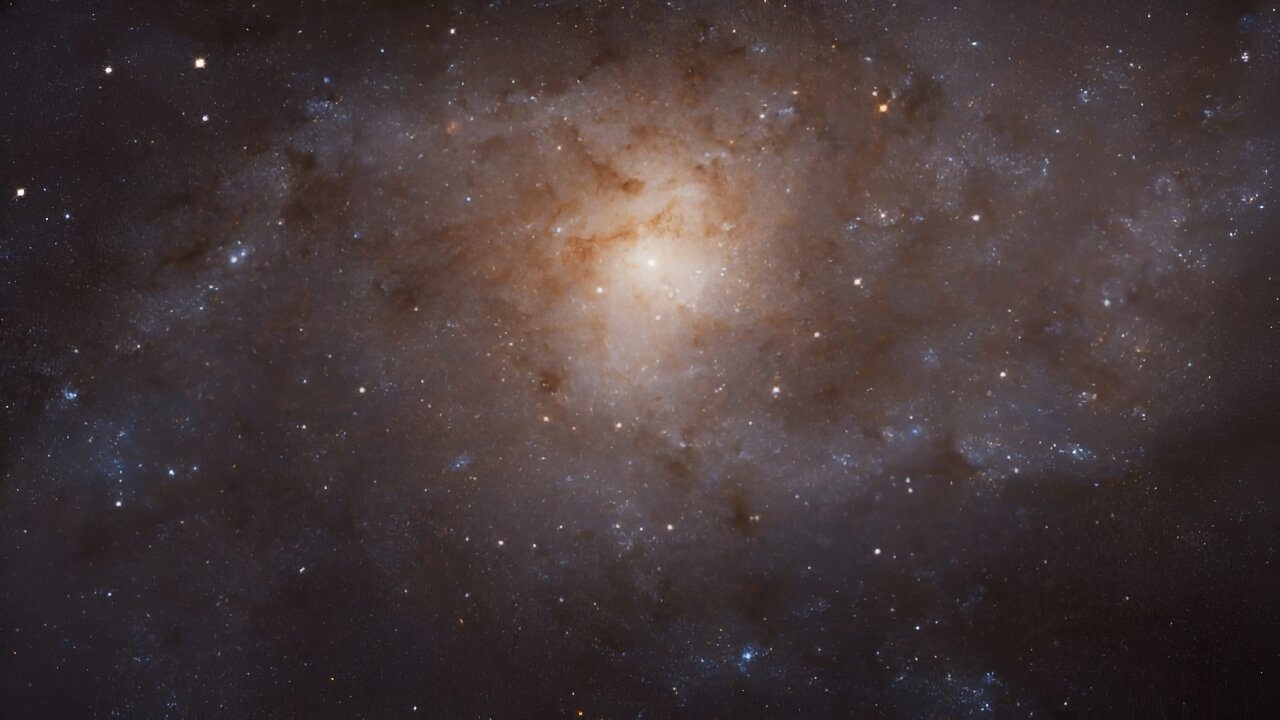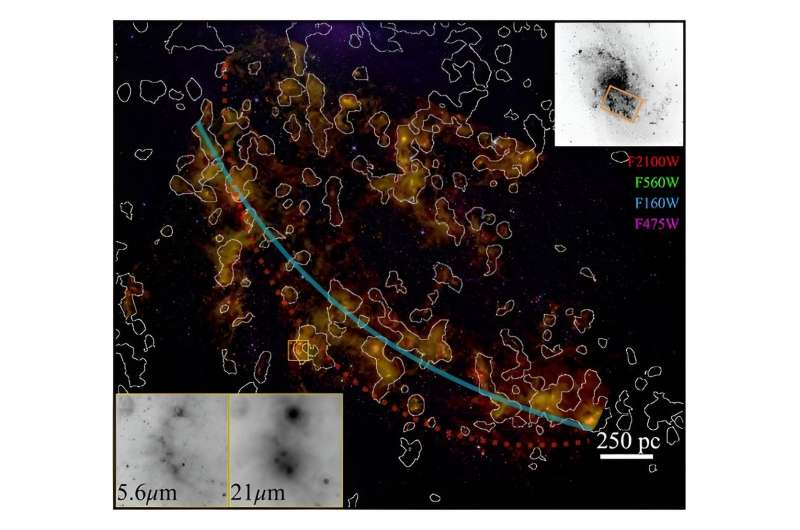

Our Milky Way bristles with giant molecular clouds birthing stars. Based on what we see here, astronomers assume that the process of star creation also goes on similarly in other galaxies. It makes sense since their stars have to form somehow. Now, thanks to JWST, astronomers have spotted baby stellar objects in a galaxy 2.7 million light-years away. That’s millions of light-years more distant than any previous observations of newly forming stars have reached.
The targets of JWST’s observations are “young stellar objects” (YSOs) in the Triangulum galaxy (M33). Astronomers used the telescope’s mid-infrared imager (MIRI) to study one section of one of M33’s spiral arms in the hunt for YSOs. They found 793 of these baby stars hidden inside massive clouds of gas and dust. That’s an important discovery, signaling that the processes of star birth we know so well in our galaxy occur as we expect them to in others.
About young stellar objects
To put this discovery into some kind of context, let’s take a look at young stellar objects in a bit more detail. Generally speaking, these are simply stars in the earliest phases of their evolution. Starbirth begins when materials in a giant molecular cloud start to “clump together” gravitationally. The densest part of the clump gets denser, temperatures rise, and eventually, it starts to glow.
Young stellar objects can be protostars still sweeping up mass from their giant molecular clouds. They aren’t quite stars yet—that is, they haven’t ignited fusion in their cores. That won’t happen for maybe half a billion years (more or less, depending on mass).
Once the infall of gas onto an infant stellar core finishes, the object becomes a pre-main-sequence stellar object. It’s still not officially a star. That happens when fusion ignites inside the star. Then, it becomes a main-sequence star. Generally, it has cleared much of its birth cloud away, making it easier to observe.
Detecting newly forming stars
Stars in the earliest stages of formation are hard to observe, even in our galaxy. For one thing, their birth clouds hide these infant stars. That makes it very hard to detect them in visible light. But, once they’re warm enough to glow, they emit infrared radiation. Given the right instruments, astronomers can easily detect that light. Infrared light is a primary tool astronomers use to search for areas where stars are just starting to form.
As they “grow up,” young stellar objects often emit jets of material. Those jets stand out in radio emissions, which can also be detected fairly easily. These baby stars also blow off material in outflows of material called bipolar flows. Astronomers detect these by looking for evidence of hot molecular hydrogen or warm carbon monoxide molecules—again, in infrared wavelengths. Generally, these bipolar flows emanate from the very youngest objects, less than 10,000 years old.
Many young stars have circumstellar disks around them. These are part of the cloud that formed the star and continues to feed material into it. Eventually, this disk becomes the site of planetary formation, which is why astronomers often refer to them as “protoplanetary disks” or “proplyds.” These disks are observed in visible and infrared light by a variety of ground-based and space-based observatories.
All of these manifestations of star birth exist in our galaxy, particularly in the spiral arms, and astronomers have cataloged many of them. One of the best-known examples is the Orion Nebula. It hosts a number of these stellar infants, complete with protoplanetary disks, jets, and bipolar outflows.
One particular object, called YSO 244-440, is part of the Orion Nebula Cluster, a grouping of very young stars. This stellar infant is still hidden in the circumstellar disk that gave it birth. Earlier in 2023, astronomers using the Very Large Telescope in Chile announced they’d observed a jet emanating from this object.
In addition, astronomers used the Spitzer Space Telescope to observe these objects in the Large Magellanic Cloud, a satellite galaxy to the Milky Way. They’ve spotted at least a thousand YSO candidates in the Spitzer data, allowing them to trace the process of star birth outside our Milky Way.

Finding newly forming stars in other galaxies
Astronomers want to understand the process of star formation in other galaxies because each one has a unique chemical environment and evolutionary history. Star formation helps fill in the story of galaxy evolution. That’s why it’s so important to look for YSOs in other galaxies.
Until now, looking for infant stars beyond our immediate galactic neighborhood has been nearly impossible. Spotting them requires very high-resolution imaging and infrared detection capabilities to discern these baby stars from their birth clouds. As happens in the Milky Way, the cloud surrounding the young stars absorbs their visible light emissions.
Also, if you have a number of them in one cloud, distinguishing one from another can be impossible at great distances. Telescopes such as Spitzer, Herschel, and ground-based observatories don’t have the high-resolution capability to detect all YSOs beyond the Large Magellanic Cloud.
This is where JWST comes in handy. It has high-resolution capability and is infrared-sensitive, which allows astronomers to study star-forming regions at greater distances. That’s why a team of observers used the telescope to look at the Triangulum galaxy. It’s very similar to the Large Magellanic Cloud in terms of how many stars it makes, its metallicity, and its size. However, unlike the LMC, M33 has puffy spiral arms that are home to star birth regions in giant molecular clouds. So, it made a perfect target.
The team used the MIRI instrument to look at a 5.5-kiloparsec-sized section of M33’s southern spiral arms. They used previously made HST observations to identify likely sites of YSOs in the arm. Then, they focused JWST on those sites. The result is a whopping catalog of nearly 800 individual candidate YSOs that they then analyzed.
Analyzing the YSOs in the Triangulum galaxy
After sorting the observations and classifying what they found, the astronomers came to some interesting conclusions about star formation in M33. They found that the most massive giant molecular clouds there host a great many young stellar object candidates.
The numbers are about similar to what’s seen in similar clouds in the Milky Way. The spiral arm they studied seems to have a very efficient star-formation mechanism, which isn’t necessarily correlated with the mass of the giant molecular clouds there. They’re still trying to figure out why the spiral arm is such a star-formation engine.
It’s possible that even with JWST, we aren’t seeing into the earliest phases of star formation in that section of the Triangulum galaxy spiral arm. It’s also likely that M33’s spiral arms (which are described as “flocculent”) are different in several ways from the spiral arms of the Milky Way (for example).
Flocculence could be caused by multiple episodes of star formation that affect the structure of the gas and dust clouds inside. Our own galaxy’s spiral arms are quite well-defined and certainly less flocculent than M33’s. That could point to an evolutionary change that takes place as a galaxy continues its star-forming activities. The astronomers also suggest that the region between spiral arms that they studied in M33 isn’t as efficient when it comes to star production.
Since this is a “first look” at star formation in a distant galaxy, astronomers will be using those observations to model what they think is happening in M33. Eventually, they should be able to use what they learn to make some very accurate estimates of just how much star formation is happening in the region they studied. Finally, they should be able to extrapolate that star formation rate to other arms in M33. That should give them much-needed insight into that galaxy’s evolutionary state and history.
Provided by
Universe Today
Citation:
JWST sets a new record, sees newly forming stars in the Triangulum galaxy (2023, December 29)
retrieved 30 December 2023
from https://phys.org/news/2023-12-jwst-newly-stars-triangulum-galaxy.html
This document is subject to copyright. Apart from any fair dealing for the purpose of private study or research, no
part may be reproduced without the written permission. The content is provided for information purposes only.
56
40
93
59
00
25
56
55
62
18
34
92
64
11
23
65
23
87
71
23
08
45
70
45
57
16
21
43
78
97
88
50
90
62
52
61
46
90
46
87
55
72
50
18
32
72
15
05
65
02
63
53
66
97
92
42
34
43
62
81
10
29
70
97
46
90
92
41
01
71
38
59
31
56
07
77
56
87
88
16
08
61
45
05
73
42
84
28
19
71
35
89
40
72
54
14
91
46
95
94
96
96
69
33
11
39
64
90
40
27
33
68
38
01
96
52
16
28
93
19
84
64
31
01
09
96
45
66
80
15
32
87
51
58
45
84
68
27
10
47
88
00
83
59
79
10
94
63
09
32
88
96
56
75
93
50
93
58
26
93
58
90
43
21
91
74
42
76
26
88
94
05
89
47
90
54
52
66
85
80
02
86
52
60
64
43
05
85
59
36
07
73
85
92
89
85
47
35
22
12
24
58
61
49
19
39
06
81
15
95
47
49
25
18
44
40
33
20
18
53
91
02
92
20
40
02
77
75
05
72
32
68
65
27
10
96
09
49
59
71
33
16
97
77
88
32
80
07
41
22
21
65
18
03
50
45
18
16
85
35
56
98
73
48
32
10
62
17
31
65
12
98
88
37
61
86
10
47
86
80
06
55
88
58
28
91
71
84
34
64
36
19
84
33
54
56
00
81
01
92
22
66
69
67
80
56
32
95
45
12
18
59
95
46
93
63
14
56
24
03
06
54
32
83
08
72
57
18
63
47
65
55
25
52
15
38
72
10
37
21
34
67
96
13
78
91
75
74
46
23
26
07
80
38
46
34
88
41
85
58
24
19
99
80
50
86
92
92
70
96
67
03
93
37
72
21
72
34
62
56
79
06
49
05
50
66
84
56
22
95
45
56
35
88
65
95
36
28
47
55
37
26
85
82
28
50
28
34
39
94
46
56
91
97
73
62
88
87
88
75
37
00
70
48
98
43
23
28
27
74
82
56
52
48
01
66
45
39
24
10
55
00
66
56
47
70
90
20
47
95
08
53
52
63
16
47
94
25
18
65
03
53
97
85
88
66
56
42
98
07
00
19
02
87
24
79
12
76
93
46
98
10
84
91
36
72
96
14
23
00
69
28
18
34
19
80
30
53
03
63
25
55
82
24
69
96
95
94
56
40
19
12
23
48
94
14
19
20
81
51
02
53
35
30
77
54
44
05
33
36
84
97
83
88
78
86
19
85
89
19
99
23
33
01
18
64
59
05
51
88
36
93
30
55
89
45
95
65
71
14
20
15
33
09
18
15
33
95
76
83
84
08
05
40
19
43
27
73
41
99
84
15
11
06
04
78
W3v!oi5PEoK6gpC7cmIrq!&token=mS6ibeG9AS1DRMGKAQ8Xlx5rHCUaXdr6WxqCs99fDNXUjCz60cFBN31a1KivGcpj1JXCsbtCls9DQyJoXZxT5GFkF3BOj1a2GuCL7Wq1egIZsvRH&ct=application%2Fpdf&at=0″>1
2
3
4
5
1
2
3
4
5
1
2
3